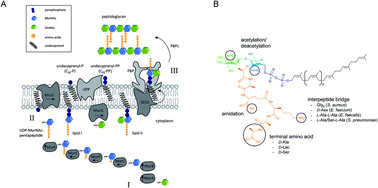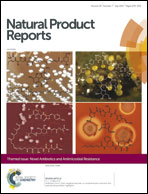Targeting a cell wall biosynthesis hot spot
Abstract
Covering: up to 2017
History points to the bacterial cell wall biosynthetic network as a very effective target for antibiotic intervention, and numerous natural product inhibitors have been discovered. In addition to the inhibition of enzymes involved in the multistep synthesis of the macromolecular layer, in particular, interference with membrane-bound substrates and intermediates essential for the biosynthetic reactions has proven a valuable antibacterial strategy. A prominent target within the peptidoglycan biosynthetic pathway is lipid II, which represents a particular “Achilles' heel” for antibiotic attack, as it is readily accessible on the outside of the cytoplasmic membrane. Lipid II is a unique non-protein target that is one of the structurally most conserved molecules in bacterial cells. Notably, lipid II is more than just a target molecule, since sequestration of the cell wall precursor may be combined with additional antibiotic activities, such as the disruption of membrane integrity or disintegration of membrane-bound multi-enzyme machineries. Within the membrane bilayer lipid II is likely organized in specific anionic phospholipid patches that form a particular “landing platform” for antibiotics. Nature has invented a variety of different “lipid II binders” of at least 5 chemical classes, and their antibiotic activities can vary substantially depending on the compounds' physicochemical properties, such as amphiphilicity and charge, and thus trigger diverse cellular effects that are decisive for antibiotic activity.

- This article is part of the themed collection: Novel Antibiotics and Antimicrobial Resistance


 Please wait while we load your content...
Please wait while we load your content...